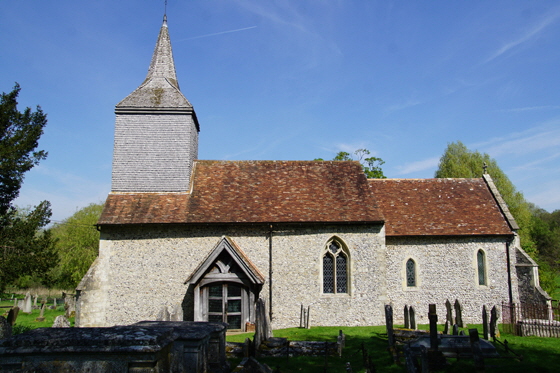|
|
|||||||||||||||||||||||||||||
|
apse. Such a church would have had the characteristically inordinate height to width ratio of Anglo-Saxon churches. The fact that the chancel arch is itself Norman tempts us to believe that today’s nave and chancel were built as a piece, relegating the old Anglo-Saxon church immediately to the status of north aisle. However, the chancel arch looks to be substantially later than the arcade. This implies that the chancel was a later addition and that only then was the putative apse replaced. This is all speculation, of course, but it is interesting that he Anglo-Saxon church theory was first propounded by JC Cox, one of the twentieth century’s most celebrated writers in parish churches. Pevsner sat on the fence. Taylor & Taylor excluded it from their definitive catalogue of Anglo-Saxon churches. But that aisle really does look A/S! Anyway, life would be much less interesting if everything was immediately explicable, so let’s move on! The Church Guide lists no fewer than eleven monuments in this small church., mainly of the Hampton and Phelyppes families. This was very much a manorial church and the plethora of monuments reflects that.. The manor itself was close by but was long ago demolished. We will talk more of the monuments in the gallery captions. Another treasure here is the a fifteenth century stone carving of the Mass of St Gregory. It is an extraordinary survival as it ought to have been smashed during the Reformation. It was discovered, according to the Church Guide, in 1897 embedded in the wall of the nave and plastered over. Apart from anything else, this is a wonderful demonstration that the populace did try to hide work of church art from the iconoclasts. More on the Mass of St Gregory in the footnote below. Two further pieces of mediaeval art are found in the form of an (admittedly small) fragment of wall painting and some nice pieces of mediaeval stained glass. Best of all, in my view, is a quite remarkable collection of mediaeval floor tiles in the north chapel. All in all, this is indeed the epitome of a “Church Crawlers Church”. One where you will hear (as I did) frequent exclamations of “Have you seen this?”. Let’s take a look |
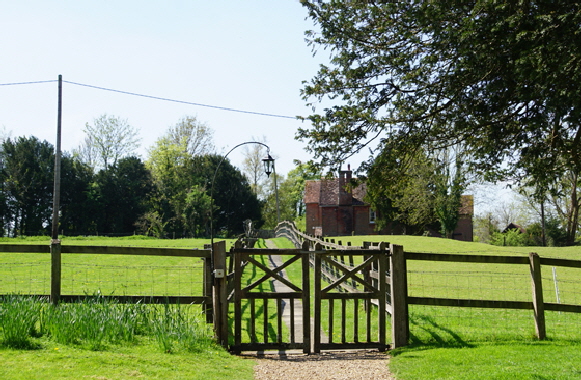 |
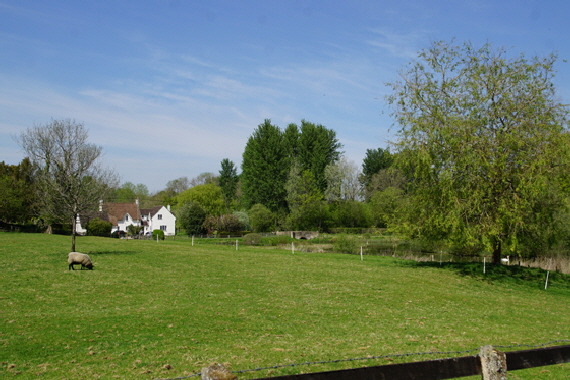 |
|
Not least of the charms of this church is its lovely surroundings. Left: The view along the footpath from the church. Right: To the south west is this quintessentially English site of a small river with a swans/ And, of course, sheep may safely graze! |
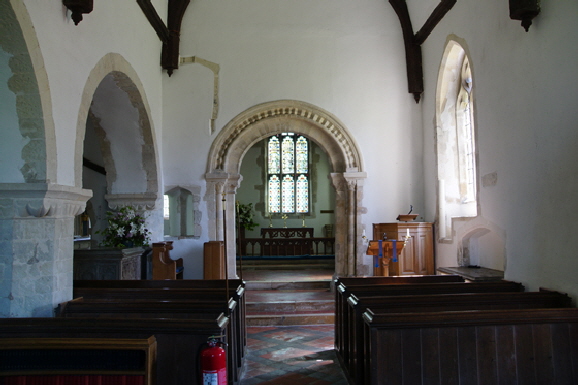 |
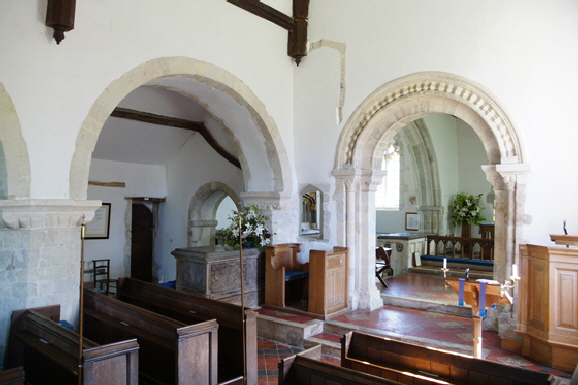 |
|
We might as well get straight into the architectural puzzle that the church presents. Left: Looking east towards the late Norman chancel arch. Right: The chancel arch again with, to its left, one of the arches of the two-bay arcade. As you can see, it is cut straight through what might or might not have been the north wall of an Anglo-Saxon church The piers of the arch are, surprisingly, octagonal with simply scalloped capitals. |
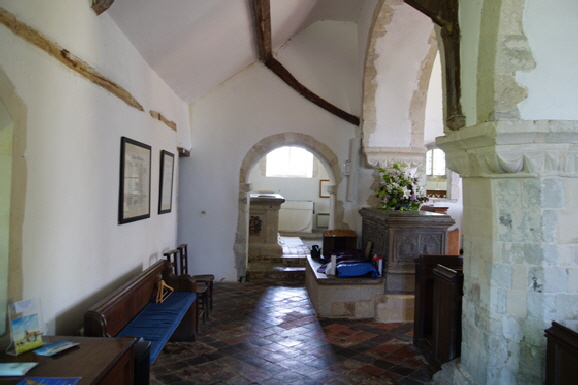 |
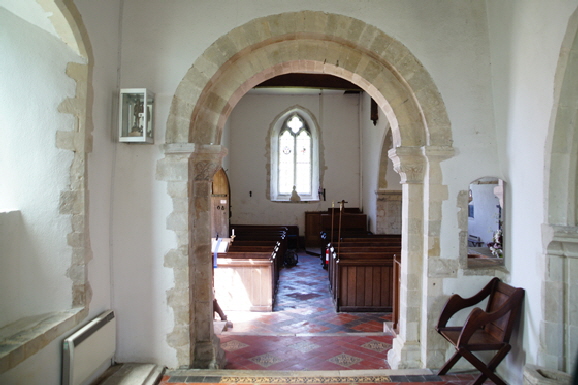 |
|
Left The north aisle, looking east. It may have been an Anglo-Saxon church with an apse where the north chapel now is to the east beyond the arch. Right: The north aisle arch seen from the east. Is it Anglo-Saxon? Well, in design it certainly looks like it. The design, though, is very neat with closely jointed stones and the stones themselves looking finely carved. If it is pre-Conquest then one rather suspects that it was not by many years. And, of course, it could simply be an Norman arch with a somewhat “retro” look. Masons did not adopt new styles overnight. |
 |
 |
||||||||||||||||||||||||||||||||||
|
Left: The chancel arch capitals have a well-crafted “palmette” design that looks late Norman, unlike the crude arches of the aisle which look later. Right: The north wall of the the north chapel. Two of the church’s super-abundance of monuments can be seen. In the far corner is the Mass of St Gregory carving. |
|||||||||||||||||||||||||||||||||||
 |
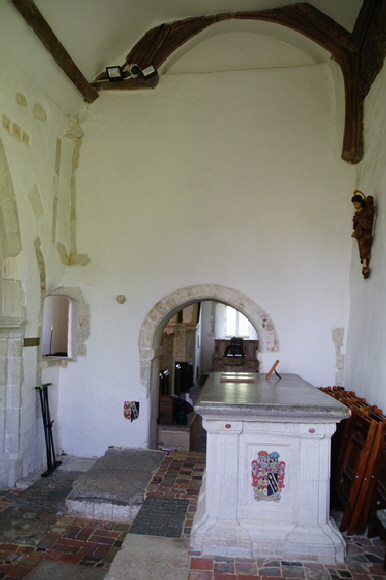 |
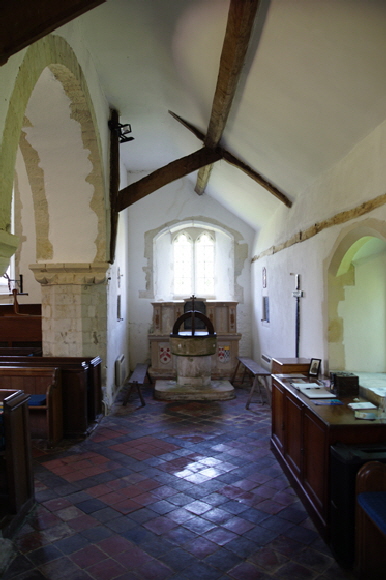 |
|||||||||||||||||||||||||||||||||
|
Left: The north wall of the chapel - th Hampton Chapel - has this monument to John Waller (d.1526) and his wife, Joan. The Church Guide reports that a jeton (reckoning counter) was found during conservation work and it is attributed to Hans Krauwinckel II of Nuremberg who lined 1586-1635. This implies that the monument was constructed sixty years after Waller’s death. This explains why the monument itself looks too late in style for 1526. Centre: Looking west from the north chapel. The seventeenth century altar tomb Sir Thomas Phelyppes (1590-1627). who married Charitie Waller. To the left of it are mediaeval floor tiles, of which more anon. Right: Looking towards the west of the north aisle where - unusually in this position,- there are several monuments. One might speculate that they were running out of space! |
|||||||||||||||||||||||||||||||||||
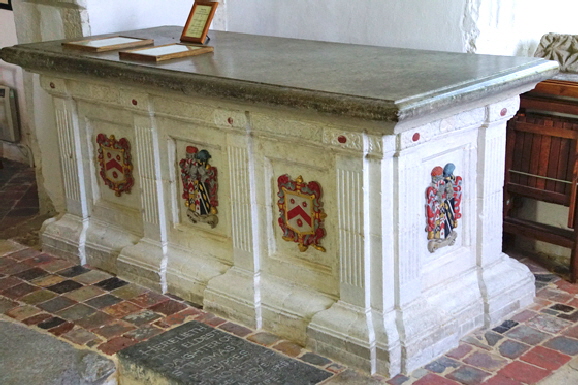 |
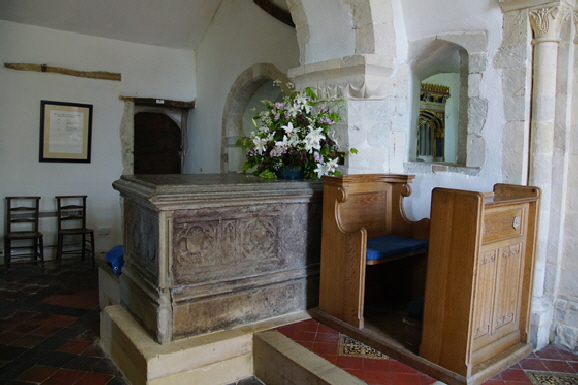 |
||||||||||||||||||||||||||||||||||
|
Left: The altar tomb of Thomas Phelyppes. In front of it a floor slab to their eldest daughter. Right: This is a somewhat older tomb that sits between the chancel arch and the north aisle. It is of Purbeck marble (which is not marble, by the way!) and is thought to be of John de Hampton who held the manor and died in 1350. |
|||||||||||||||||||||||||||||||||||
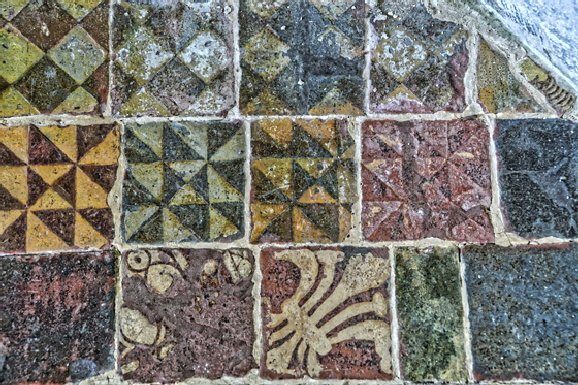 |
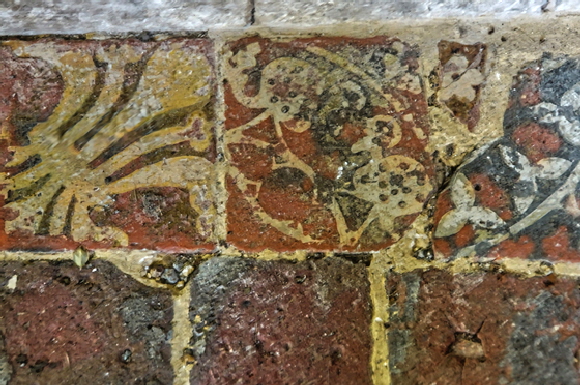 |
||||||||||||||||||||||||||||||||||
|
Left and Right: Fourteenth century floor tiles in the north chapel, placed here recently to reduce footfall. The Church Guide says they are similar to those in nearby Winchester Cathedral. This is an extraordinarily large and varied collection for a parish church. |
|||||||||||||||||||||||||||||||||||
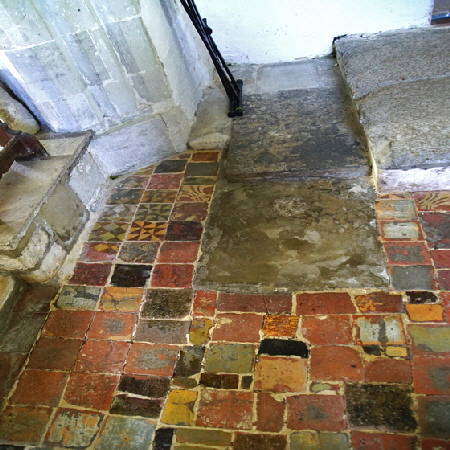 |
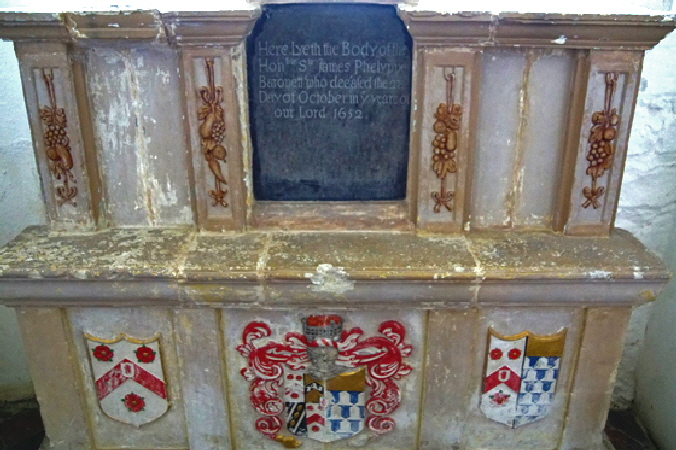 |
||||||||||||||||||||||||||||||||||
|
Left: The mediaeval floor tiles. We could not believe we were allowed to walk on them! Right: At the west end of the north aisle is the tomb chest of Sir James Phelyppes (d.1652). |
|||||||||||||||||||||||||||||||||||
 |
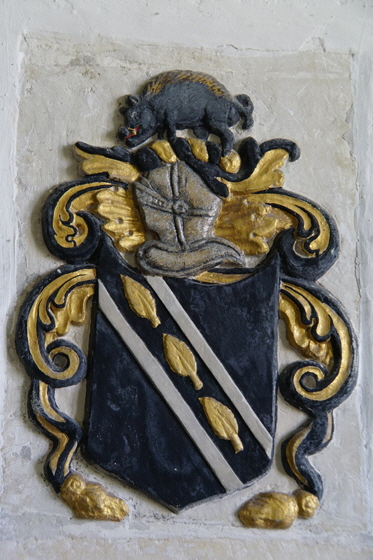 |
 |
|||||||||||||||||||||||||||||||||
|
This church is full of monuments but would be of equal interest to anyone who loves heraldry. You will see many crests and coats of arms on this page and it is fascinating how the family arms become coalesced through marriage. Mediaeval families were anxious to show their aristocratic allegiances which could be a source of advantage in gaining favour or position within society. I don’t intend to explain these many crests in detail but note (centre and right) the rather wonderful black boar on the monument to Charitie Ogilvie who died in 1645 |
|||||||||||||||||||||||||||||||||||
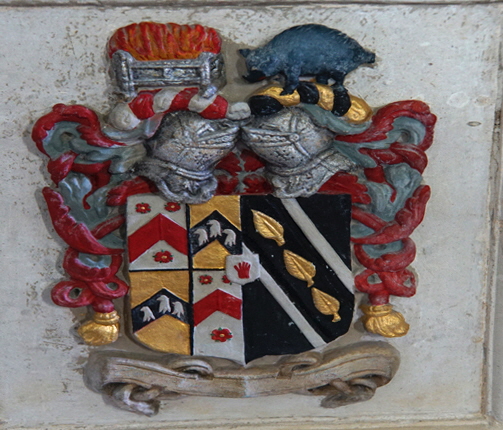 |
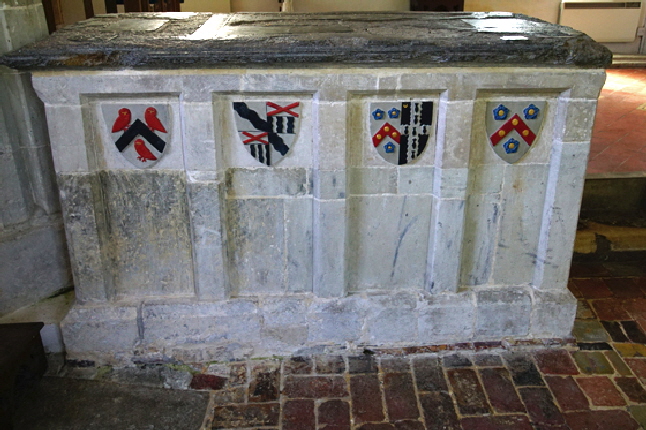 |
||||||||||||||||||||||||||||||||||
|
Left: Here we can see the Ogilvie arms conjoined with the another which has a blazing fire at its head. Right: The tomb of Thomas Wayte (d. 1482). The chest is plain but note that the heraldry is different from the Hampton/Waller crests elsewhere in the church. The plainness of the chest, however, is offset by the rather wonderful brass set into its Purbeck marble top. See below. |
|||||||||||||||||||||||||||||||||||
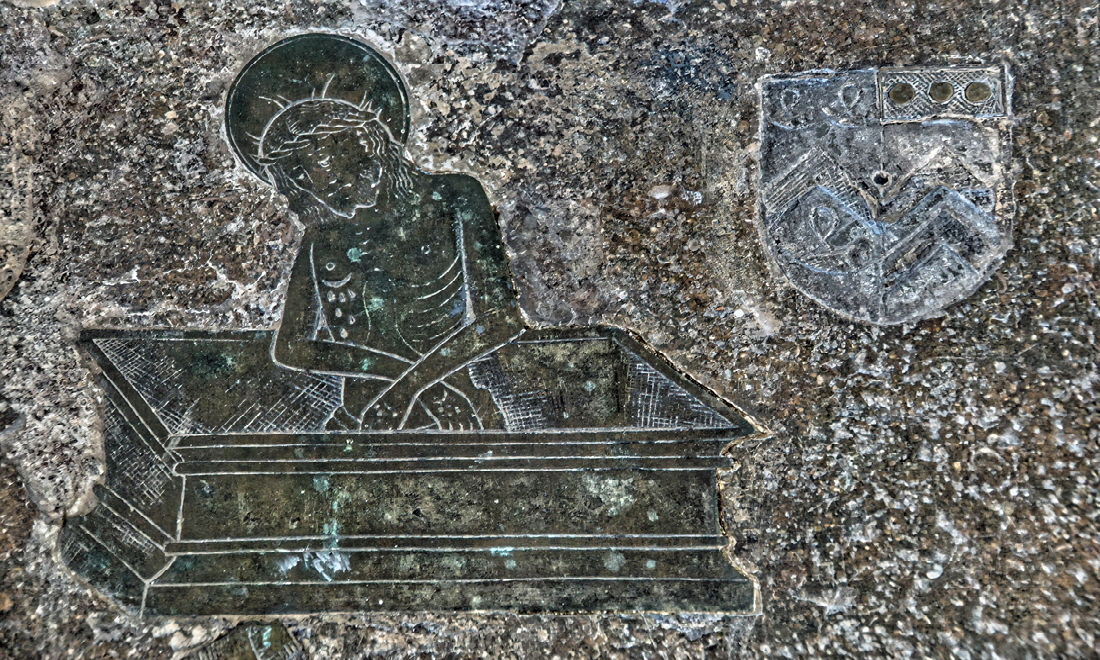 |
|||||||||||||||||||||||||||||||||||
|
This sort of imagery on a funerary brass is very unusual. This image of Christ emerging from a coffin - not from a tomb - is set into the Thomas Wayte tomb chest (see above) |
|||||||||||||||||||||||||||||||||||
 |
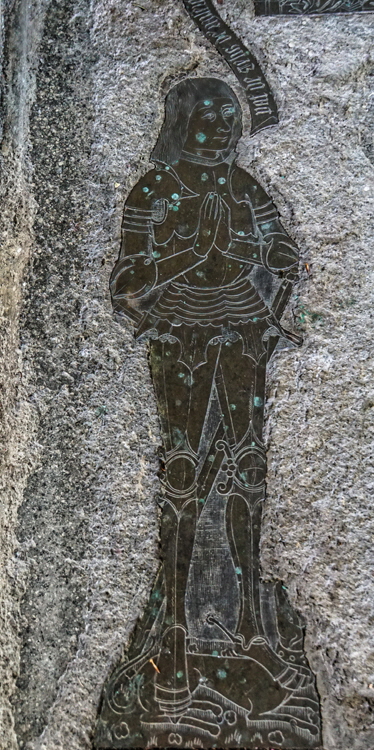 |
||||||||||||||||||||||||||||||||||
|
Brass effigies on the tomb chest of Thomas Hampton (d.1483) and his wife, Isabella (d1473), located in the Hampton Chapel. Left: Sadly, Isabella’s brass is mainly lost., Note the unusual crucifixion scene et the top - unique in ,my experience. Right: The image of Thomas himself. |
|||||||||||||||||||||||||||||||||||
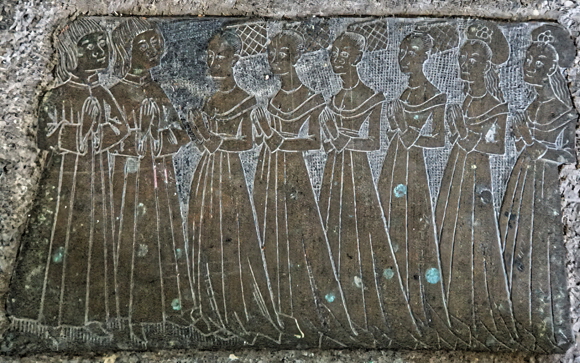 |
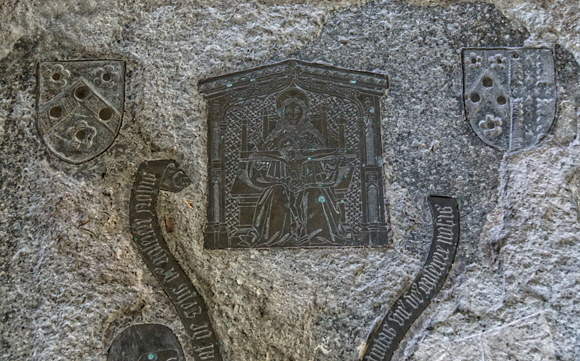 |
||||||||||||||||||||||||||||||||||
|
Left: The “weepers” at the bottom of the brass, not visible in the pictures above. The wearing of huge butterfly head dresses seems to have been a real fashion on brasses (and presumably in real life) at that time. The two figures to the right, however, wear different head gear because they were unmarried. Right: The top of the slab shows the crucifixion scene and yet more heraldry. |
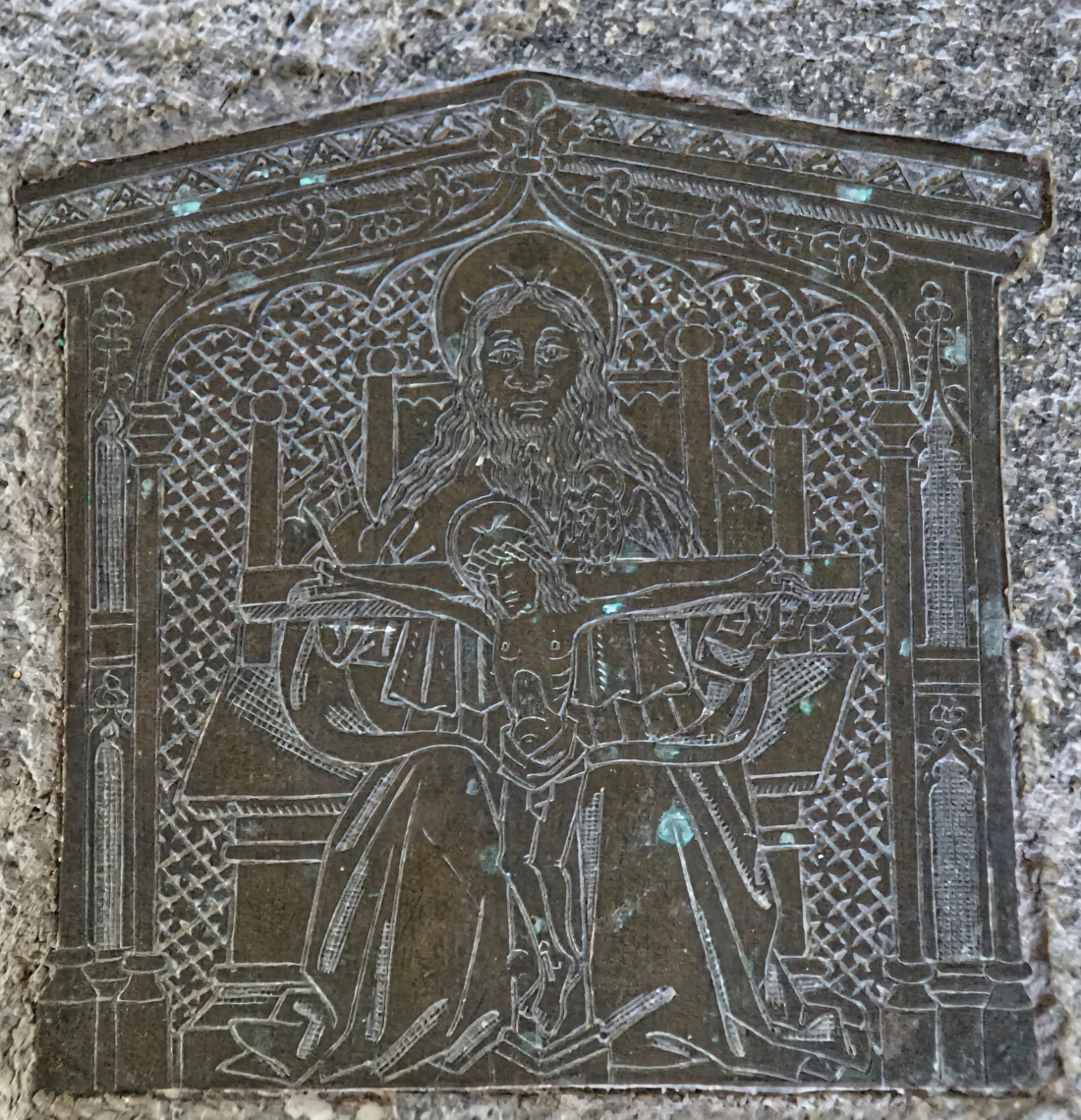 |
||||||||||||||||
|
The superb and very unusual crucifixion scene. In fact, it is perhaps a surprise that it survived both the Reformation and the Commonwealth. It epitomises everything that I find compelling about our parish churches: the artisanal skill and devotion by a man dead for six hundred years. It is one of a kind in a one of a kind setting, wholly unexpected, not at all celebrated and totally beguiling. |
||||||||||||||||
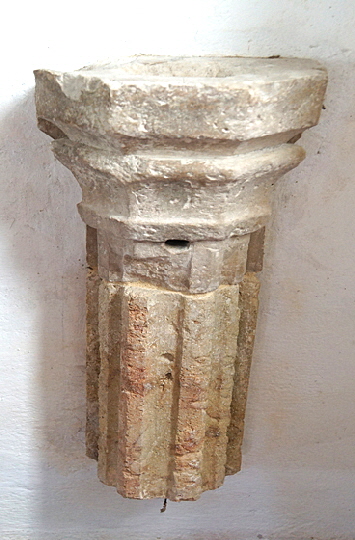 |
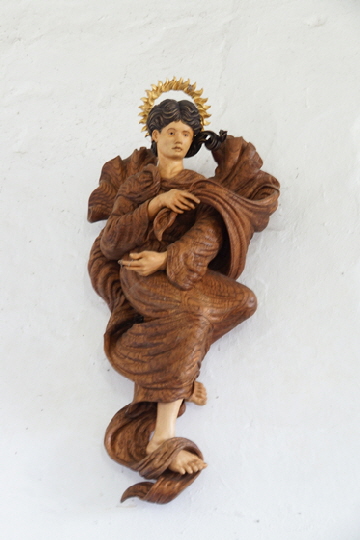 |
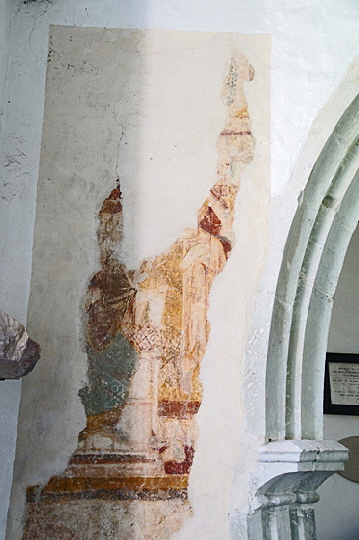 |
||||||||||||||
|
Left: A pillar piscina. These are quite rare and normally Norman but this one doesn’t look like it is. It is no longer in use and is mounted on the wall. Centre: A carving of the Virgin Mary, carved by Alex Jones. A late C20 piece used to commemorate the millennium. It is quite unorthodox, showing Mary with luxuriant hair and in monk-like brown robes. Her feet are bare. I am no great fan of Anglo-Catholic imagery but I find this portrayal of Mary looking very “human” and humble rather than in “her glory” rather appealing. Right: A fragment of wall painting in the Hampton Chapel. |
||||||||||||||||
 |
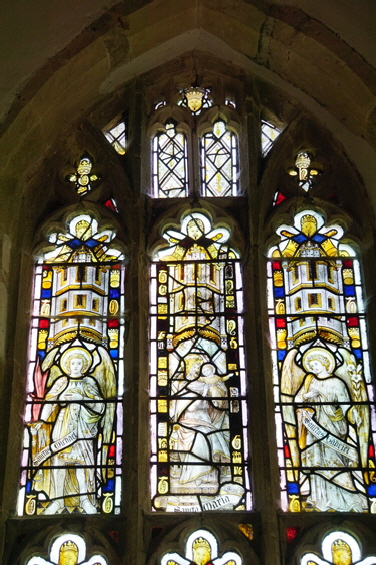 |
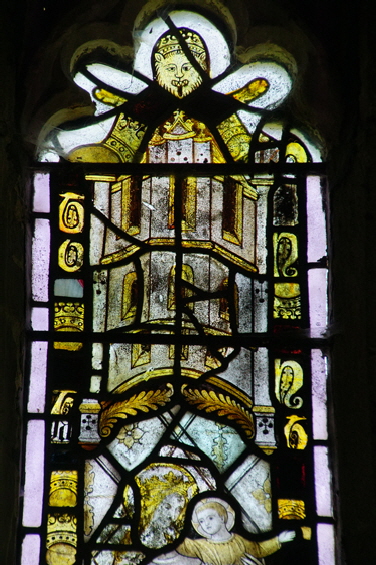 |
||||||||||||||
|
Left: The fifteenth century sculpture of the Mass of St Gregory, an extremely rare figurative survivor of the Reformation and Commonwealth. The Church Guide says that only two other exist: at Exeter Cathedral and at Paignton Church (both in Devon). Centre: The east window. The glass dates only from 1908 but it is believed to have replicated the original design and to have incorporated remains of the original. Right: This central panel of the east window indeed seems to incorporate quite a lot of the original glass. Note the “TH” initials, commemorating Thomas Hampton (d.1483) whose tomb chest we see elsewhere in the church (above) |
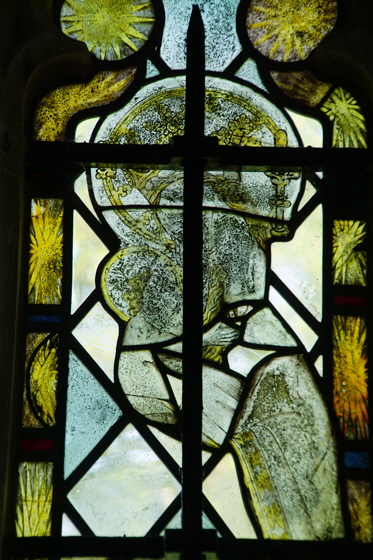 |
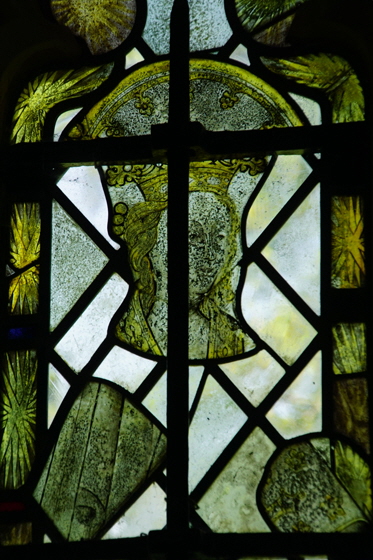 |
 |
|
Left and Centre: two fragments of glass in the Hampton Chapel. One is St Margaret of Antioch, the other the crowned Virgin Mary. Above them are the “Suns of York”, adopted by Edward IV after the Battle of Mortimers Cross in 1461. He was said to have seen three suns in a clear sky before the battle in which he was victorious against a lancastrian army led by Owen Tudor. Right: The south door. |
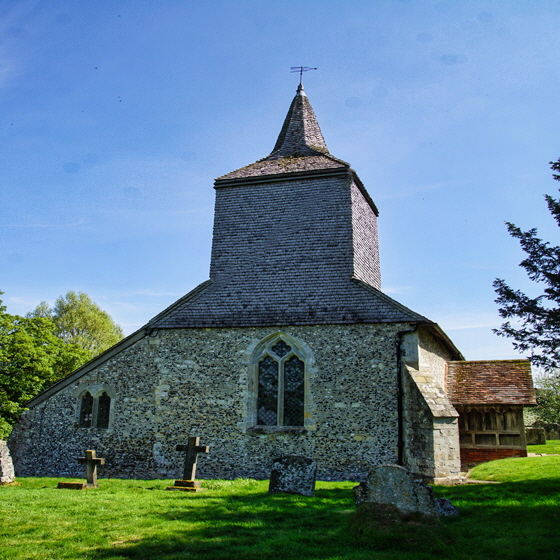 |
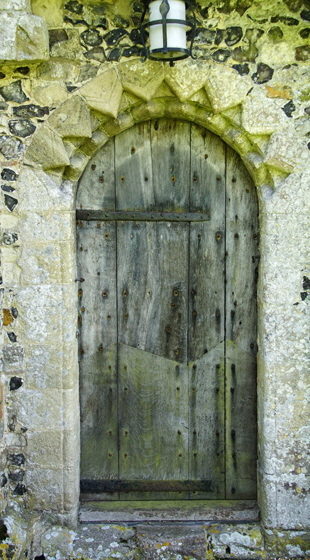 |
||||||
|
Left: The church from the west. The tower is hung with tiles. Note the steep pitch of the aisle roof, unchanged since Norman or Anglo-Saxon times. Such a steep pitch would have facilitated the speedy removal of snow from the roof at a time when roof materials were far from impervious. Right: The Norman doorway on the north side of the church. |
|||||||
|
Footnote - The Mass of St Gregory |
|||||||
|
This is the subject of the fifteenth century sculpture seen above. The story is that Pope Gregory the Great - the man who sent St Augustine to England in AD597 - knew that there was someone in his congregation who did not believe that the Eucharist turned to the real body and blood of Christ. You might find that truly amazing! Amazing too was that although he knew there was a doubter in his presence he did not know who it actually was. Gregory - as you do - asked Christ to appear to convince the man which, of course, he obligingly did. |
|
|
|
|
|
|
I hope you have enjoyed this Page and, perhaps, many more besides. Could you help me to make it better still and preserve its future? |
